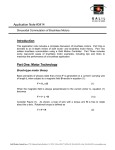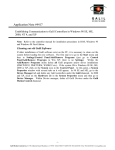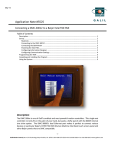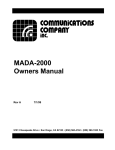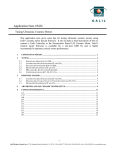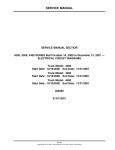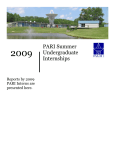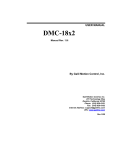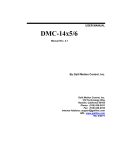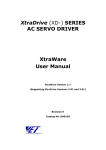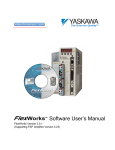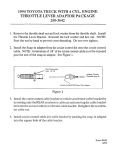Download Application Note 2501: DMC-18x6 Series
Transcript
May-07 Application Note #2501 Accelera Series Command Set Changes (New, Modified and Removed Commands) Overview The DMC-18x6 PCI bus controller is part of Galil’s latest generation motion controller family: the Accelera Series. Incorporating a 32-bit RISC-based microcomputer, these new controllers offer high-speed performance and processing power. Speed improvements include acceptance of encoder inputs up to 22 MHz, servo update rates as low as 24 microseconds/axis, and command execution speeds as low as 40 microseconds. The DMC-18x6 is also equipped with larger RAM and FLASH resulting in increased program space with 2,000 lines (x80 characters/line), 16,000 array elements and 510 user defined variables. The command set of the Optima series is the basically the same on the Accelera controllers. However, some commands have been modified to optimize the increased power of the Accelera controller, and new commands have been added to the DMC-18x6 command set. This means that a program written for an Optima controller will NOT work the same on an Accelera controller. This application note discusses command modifications that must be considered to convert a program from a DMC-18x0 to a DMC-18x6. The new commands for the DMC-18x6 are also listed in this bulletin. PID Changes When using control parameters for an Optima controller on a new Accelera controller, the values for KP, KD, and KI must be scaled. KP and KD must be increased by a factor of 4 compared to what would have been used on an Optima controller. KI on the other hand, must be divided by 2 in order to have an equivalent Integral Loop. The resolution of KI is 1/128 for Optima controllers, and is 1/1024 for Accelera controllers. The effective resolution of KP and KD has been increased by 4, but the command resolution is still 0.125. Therefore, to convert PID parameters from a DMC-18x0 to their equivalent DMC-18x6 parameters, multiply KP and KD by 4, and divide KI by 2. Example : If the DMC-18x0 PID parameters were KP=10, KD=100, and KI=4, then the DMC-18x6 new PID parameters will be KP=40, KD=400 and KI=2. -1Galil Motion Control, Inc. • 3750 Atherton Road • Rocklin, CA 95765 USA • 800-377-6329 • Ph: 916-626-0101 • Fax: 916-626-0102 • www.galilmc.com Other Considerations Hardware Latch for Find Home and Find Index With the DMC-18x6 controller, the Homing Routine and Find Index Routine now both use a hardware latch to define the index position. This latched position is returned to and defined as 0. In prior generation controllers, the index was not latched. Programmable Homing and Find Index Speed The slew speed for the final 2 stages of the homing routine, and the last stage of the Find Index Routine are set by the new HV (Homing Velocity) command. The default for HV is 256 counts/sec. Replacement of VT command by IT The VT command has been removed from the DMC-18x6 command set. The functionality of the IT command has been expanded to operate over the entire sequence of a vector or linear interpolated sequence of moves. The IT command is now effectively a 1st order low pass filter which smoothes out basic movements, coordinated motion and contoured mode motion. While in coordinated vector motion, the IT command will act on the individual vector components. This is different than the VT command which acted over the resultant vector movement. Because of the expanded functionality of the IT command, the VT command is no longer needed. Removal of WC command in Contour Mode The architecture of the contour mode has changed with the DMC-18x6. The moves are now buffered similar to that of Vector and Linear Interpolation moves. Because of this, WC has been removed from the new command set, and CD has been modified to operate without the need of WC. Removal of Stepper Motor Jumpers The Stepper Motor Jumpers have been removed from the DMC-18x6 controller. For operating in Stepper mode, MT must be set to the correct setting, but no hardware needs to be changed. Servo drives that accept a PWM signal for their motor command will now use MT 1.5, rather than having the SM jumpers installed and an MT of 1. -2Galil Motion Control, Inc. • 3750 Atherton Road • Rocklin, CA 95765 USA • 800-377-6329 • Ph: 916-626-0101 • Fax: 916-626-0102 • www.galilmc.com The following pages contain a complete list of new commands and command set changes. New Commands for the DMC 18x6 % This new Math Operand will return the integer remainder of a division. This operand is especially useful for rotary applications where knowledge of an absolute position is desired. For example, the position of a motor shaft can be found in degrees between 0-360O by using the following sequence of commands. V1=_TPX%4000 Angle=360*(V1/4000) In this example, if TPX is 4350, then V1 will be 350, and the angle will be 31.5O. EY CAM Cycle Count. This command is used to determine the absolute position of an axis that is involved in an ECAM profile, and to also simply report how many ECAM cycles have been executed. It returns the number of ECAM cycles that have been executed. To determine the absolute position of an axis while in ECAM mode, the formula below is used: Absolute Position = EM*EY +TP EY may be initialized or reset by the user by issuing EYn, where n is the ECAM cycle count. HV Homing Velocity. Useful when using custom homing routines, this function will set the slew speed in the last stage of the FI routine, and in all stages except the first in the HM routine. See FI and HM in 18x6 Command Reference. LD Limit Disable. This command can be used for debugging an application that is subject to noise problems that may be tripping the limit switches. Setting this command will cause the controller to ignore when a limit switch has been reached. When the Limit Switches are disabled, _LF and _LR will still return the state of the limit switch. ^L^K Lock Program. This new command locks user access to the application program. When locked, error #106 will occur if ED, UL, LS or TR commands are executed. OA Off on Encoder Error Failure. This command turns on and off the encoder failure feature. The threshold for encoder failure is established with the OV command. See OT and OV below. OT Off on Encoder Failure Time. This command establishes the time, in number of samples, which the controller will wait for motion before issuing an error due to encoder failure. The OV command sets voltage threshold that will trip the OT to start. See OV below. -3Galil Motion Control, Inc. • 3750 Atherton Road • Rocklin, CA 95765 USA • 800-377-6329 • Ph: 916-626-0101 • Fax: 916-626-0102 • www.galilmc.com OV Off on Encoder Failure Voltage. Sets the threshold voltage pertaining to the commanded torque output of an axis in which the OA command has been set. If the controller has failed to register a change of at least 4 encoder counts by the time defined by OT have passed after the torque threshold has been exceeded, then an Encoder Failure will occur. PW Sets the password for the ^L^K lock setting. SD Limit Switch Deceleration. SD sets the deceleration rate (counts/second2) that will be used when a limit switch is reached. This eliminates the need to immediately set DC in a #LIMSWI subroutine. Like AC and DC, SD defines rates from 1024 to 1,073,740,800 counts/sec2 in increments of 1024, and is individually specified per axis. ZA User Data Record Variables. ZA allows the user to write data to part of the data record. There are 4 bytes of memory available per axis. This is useful if there is a need to send extra information when retrieving the data record, or if there is a need to visually monitor a variable while viewing the data record. Modified Commands for the DMC 18x6 AC/DC Acceleration and Deceleration Rates. The ranges of AC and DC commands have been expanded. On an Optima series controller the range is 1024 to 67,107,840 counts/sec2. With the new Accelera series controller, the range of AD and DC is now 1024 to 1,073,740,800counts/sec2. Automatic Except for #CMDERR, all automatic subroutines in the Galil software Subroutines architecture no longer require thread 0 to be running in order for them to operate. This means that if a program fails and thread 0 stops running, the automatic subroutines such as #LIMSWI, will still operate. AL Arm Latch. The latch function of the controller can be used to very accurately capture the encoder position of an axis via a digital input. For the Accelera series controllers, this command has been expanded so that a high speed capture of the encoder position can be latched to the index pulse. CD Contour Data. The CD command has been modified for use without the WC command. See WC below. ER Error Limit. The range of the Error Limit command has been expanded. On an Optima series controller, the range or ER is 1 to 32,767 counts. With the new Accelera series controller, the range of ER is now 1 to -4Galil Motion Control, Inc. • 3750 Atherton Road • Rocklin, CA 95765 USA • 800-377-6329 • Ph: 916-626-0101 • Fax: 916-626-0102 • www.galilmc.com 2,147,483,647 counts. A value of -1 will still disable the position error limit for the specified axis. Homing Homing Routine. The homing routine now uses a hardware latch to mark the position of the index, and will return to that position on the final move of the routine with a speed specified by the HV command. This is different from the Optima controllers, where the index triggered a high deceleration stop, and the position is defined when motion had ceased. IT The functionality of the IT command has been expanded to operate over the entire sequence of a vector or linear interpolated sequence of moves. The IT command is now effectively a 1st order low pass filter which smoothes out basic movements, coordinated motion and contoured mode motion. While in coordinated vector motion, the IT command will act on the individual vector components. This is different than the VT command which acted over the resultant vector movement. Because of the expanded functionality of the IT command, the VT command is now longer needed. JG/SP Jog and Speed. The range of the SP and JG commands has been expanded. On an Optima series controller, the range of SP is 0 to 12,000,000 counts/sec for servo motors and 0 to 3,000,000 steps/sec for steppers, and the range of JG is +/-12,000,000 counts/sec for servos and +/-3,000,000 steps/sec for steppers. With the new Accelera series controller, the range of SP is now 0 to 22,000,000 counts/sec for servos and 0 to 6,000,000 steps/sec for steppers, and the range of JG is +/22,000,000 counts/sec and +/-6,000,000 steps/sec for steppers. KP/KD/KI PID Filter Parameters. When using control parameters for an Optima controller on a new Accelera controller, the values for KP, KD, and KI must be scaled. KP and KD must be increased by a factor of 4 compared what would have been used on an Optima controller. KI on the other hand, must be divided by 2 in order to have an equivalent Integral Loop. The resolution of KI is 1/128 for Optima controllers, and is 1/1024 for Accelera controllers. The effective resolution of KP and KD has been increased by 4, but the command resolution is still 0.125. LC Low Current Stepper Mode. Rather than just using a 1 for “on” or a 0 for “off”, any number from 1 to 32,767 may be used to activate this mode. A non-zero number represents the number of samples after the motion is complete in which the controller will wait until Low Current Stepper Mode is activated. A zero is normal (stepper drive always on) operation. M-Axis M Virtual Axis. A second virtual axis has been added to the Accelera series controllers. This gives even more flexibility and versatility to applications involving ECAM and Geared motion. This axis, like the N axis, may be used as the master axis in ECAM mode. -5Galil Motion Control, Inc. • 3750 Atherton Road • Rocklin, CA 95765 USA • 800-377-6329 • Ph: 916-626-0101 • Fax: 916-626-0102 • www.galilmc.com MT1.5 _NO Motor Type. Setting MT to 1.5 for a given axis will send a PWM signal over the PWM/STEP OUT line and a high or low direction signal over the Sign/Direction line of the DMC 18x6. This is useful when using a servo driver that accepts a PWM signal for motor command. An MT of 1.5 on the DMC 18x6 is the same as setting MT to 1 and having the SM jumper installed for that axis when using the DMC 18x0 series controllers. No Operation. _NO is an operand which gives the decimal value of a binary representation of which threads are running on the controller. The decimal value can be interpreted by the equation: n = n0 + 2*n1 + 4*n2 + 8*n3 +16* n4 +32* n5 +64* n6 +128* n7 Where nx represents the thread. A 0 means no threads are running, and 255 means that all threads are running. OE2 Off On Error. The Off On Error command now has the capability to automatically shut off the motor command signal when a limit switch is triggered. The options now for the OE command are Motor off by position error or abort input, Motor off by Limit Switch being triggered, or both. TM Update Time. Most functions that were previously affected by changes to the Update Time are now automatically scaled by the controller and there is no need for the user to manually make changes to those functions. The three functions that are not scaled with the new controller are KD, KI and PL. True Dampening = KD*TM True Integral = KI/TM See PL in user manual for effect of TM. TRn,m Trace. The trace function can now be configured to specify which threads to trace and send their commands down the communications port prior to execution. This is done by specifying m as a decimal value that is determined by using the binary weighted formula given below. m = n0 + 2*n1 + 4*n2 + 8*n3 +16* n4 +32* n5 +64* n6 +128* n7 Where nx represents the thread. TR 1,7 will command the controller to trace threads 1,2 and 3. VA/VD Vector Acceleration and Deceleration Rates. The ranges of VA and VD commands have been expanded. On an Optima series controller the range is 1024 to 68,461,360 counts/sec2. With the new Accelera series controller, the range of VA and VD is now 1024 to 1,073,740,800 counts/sec2. -6Galil Motion Control, Inc. • 3750 Atherton Road • Rocklin, CA 95765 USA • 800-377-6329 • Ph: 916-626-0101 • Fax: 916-626-0102 • www.galilmc.com VS Vector Speed. The rand of the VS command has been expanded. On an Optima series controller the range is 2 to 12,000,000 counts/sec for servo motors and 2 to 3,000,000 steps/sec for steppers. With the new Accelera series controller, the range of VS is now 2 to 22,000,000 counts/sec for servo motors and 2 to 6,000,000 steps/sec for steppers. Removed Commands and Hardware for the DMC 18x6 DU Dual Port RAM Access. This command was used to set the controller in Dual Port RAM (DPRAM) mode on the later versions of the DMC 18x0 series controllers that were retrofitted with DPRAM hardware. The DMC 18x6 controllers are all equipped with DPRAM hardware and no longer use secondary FIFO hardware interface for secondary communications. As with the DMC 18x0 series controllers, the DPRAM (and therefore data record) is not available with fast firmware. The DR command is still used to configure DPRAM update rate and to turn off/on the secondary communications channel. QR Data Record. Bus-based controllers with DMA, secondary FIFO or DPRAM do not accept the QR command. The DMC 18x6 controllers all have DPRAM, and therefore there is no need for the QR command with this line of controllers. The QZ command is used to obtain data from the Data Record. SM Jmprs Stepper Motor Jumpers. The stepper motor jumpers have been removed for the DMC 18x6 controller. With the increased functionality of the MT command, and an change in hardware layout, the SM jumpers are no longer required to change between stepper motor and servo motor operation. VT Vector Smoothing. See IT above. WC Wait for Contour Data. Contoured mode motion is now buffered in a similar way as both LM and VM commands are in other Galil controllers. Because of this, there is no longer a need to wait for the contour to complete before sending another CD command. _CM now returns a 0 when the buffer is full and 511 when it is empty. -7Galil Motion Control, Inc. • 3750 Atherton Road • Rocklin, CA 95765 USA • 800-377-6329 • Ph: 916-626-0101 • Fax: 916-626-0102 • www.galilmc.com







